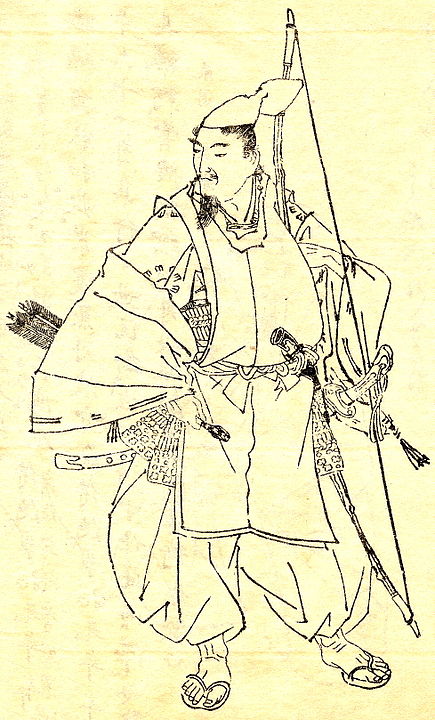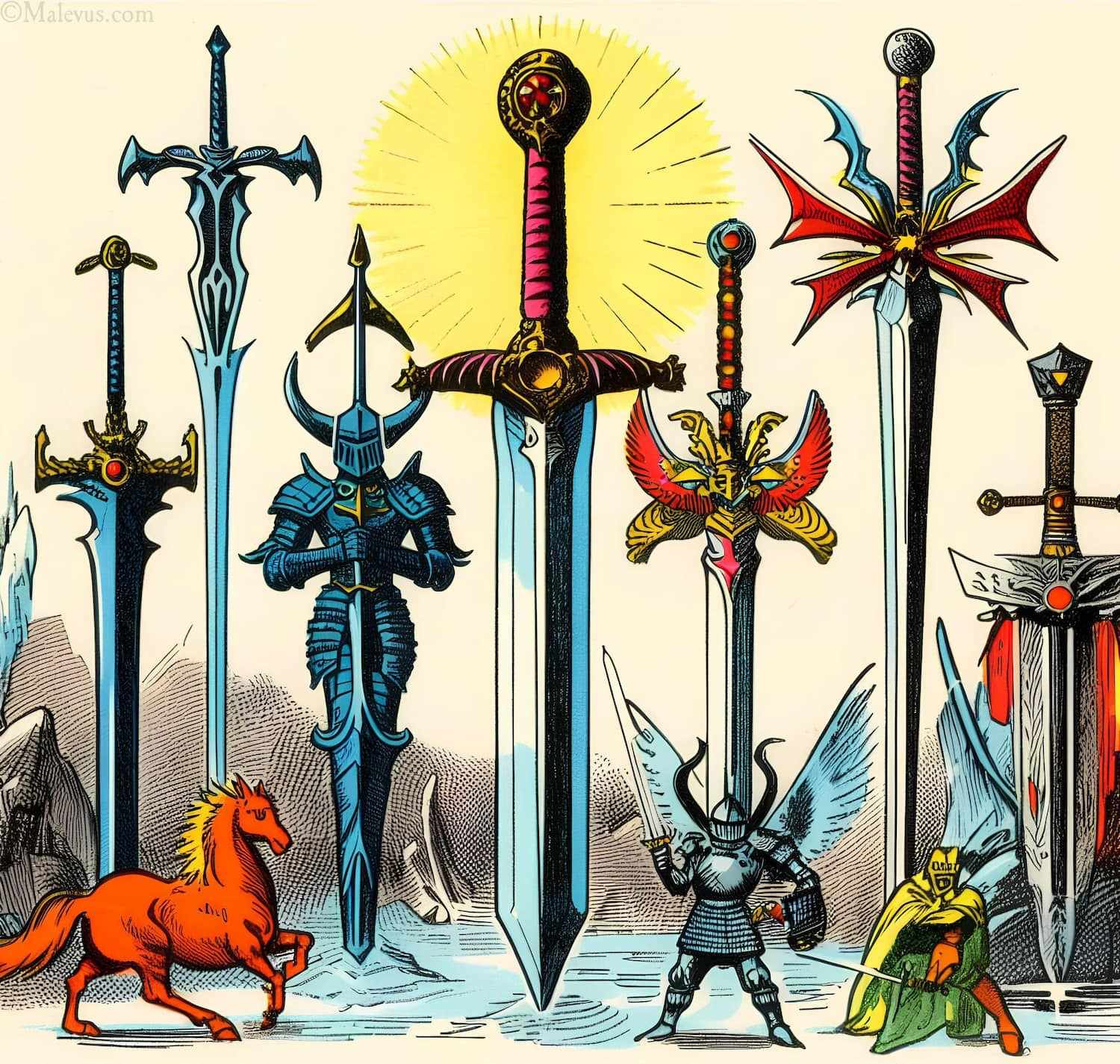Swords have been an integral part of human history, serving as tools of both survival and power. Among the countless swords forged throughout the ages, some have risen to legendary status, transcending their utilitarian role to become symbols of valor, chivalry and mythology. In this list, we have collected the stories of swords with mythological and historical qualities.
Legendary Swords
Tizona
The sword of El Cid, a Spanish hero and military leader in the 11th century. It played a significant role in the Reconquista.

Tizona is one of the two swords (along with Colada) attributed to the Cid Campeador, Rodrigo Díaz de Vivar, a hero of the Spanish Reconquista in the 11th century according to tradition or literature.
According to the Cantar de mio Cid, an epic poem composed around 1200, Tizona belonged to the King Búcar of Morocco, and El Cid took it from him in Valencia. He later gave it to his nephew Pedro Bermúdez.
Several swords preserved in Spanish museums are known as Tizona, but none can be directly linked to El Cid. They might be replicas made from fragments of ancient swords.
The most famous sword called Tizona is exhibited in the Burgos Museum. It measures 103 cm in length and weighs around 1.1 kg. It bears two inscriptions in Latin: “IO SOI TISONA FUE FECHA EN LA ERA DE MILE QUARENTA” and “AVE MARIA GRATIA PLENA DOMINUS TECUM.”
Another purported Tizona sword was part of the Crown of Castile’s treasury and was inventoried in 1503 at the Alcázar de Segovia. It could be the same sword currently housed in the Real Armería in Madrid.
A third sword called Tisó belonged to the kings of Aragon and was described by James I of Aragon in his Llibre dels fets. There doesn’t appear to be a connection with El Cid, but rather a coincidence of the name.
Excalibur
Of Arthurian legend, this sword was said to be wielded by King Arthur. It possessed magical qualities and was associated with the Lady of the Lake.

Excalibur is the legendary sword of King Arthur, the mythical ruler of Britain in the Middle Ages. The sword has various extraordinary properties attributed to it in different versions of the legend and the stories that followed. Some of the most common features of Excalibur are:
- Arthur received the sword from the Lady of the Lake, a mysterious enchantress residing in a lake.
- This sword possessed extraordinary qualities, rendering it unbreakable and invincible in battle, capable of cutting through any armor or shield.
- Moreover, it came with a scabbard that had the unique ability to prevent the wearer from bleeding or losing blood from any wound.
- Notably, only the true king of Britain could wield it; no one else could extract it from the stone in which it was embedded.
- Furthermore, upon Arthur’s demise, the sword needed to be returned to the Lady of the Lake; failure to do so would result in Britain’s descent into chaos and ruin.
Excalibur is one of the most famous and iconic symbols of the Arthurian legend, and has inspired many works of art, literature, and media throughout history.
Kusanagi-no-Tsurugi
A legendary sword in Japanese folklore, it is one of the three Imperial Regalia of Japan. The sword is associated with the Shinto god Susanoo.
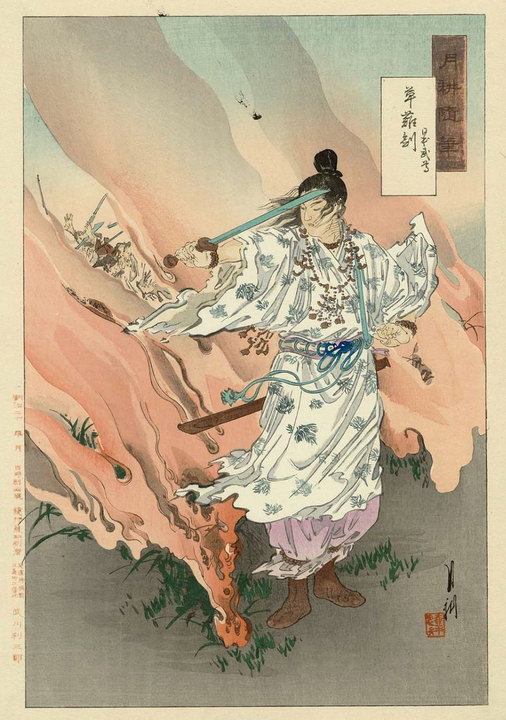
Kusanagi-no-Tsurugi is a legendary Japanese sword and one of the three Imperial Regalia of Japan. Its original name is Ame no Murakumo no Tsurugi, meaning “Sword of the Gathering Clouds of Heaven”.
The sword has a long and rich history in Japanese mythology and folklore. It is said to have been given to the god Susanoo by the dragon Yamata-no-Orochi, whom he slayed to rescue the princess Kushinada. Susanoo then presented the sword to his sister, the sun goddess Amaterasu, as a token of reconciliation. The sword was later passed down to the imperial family of Japan and became a symbol of their divine right to rule.
- The sword is also featured in many works of art, literature, and media, such as the manga and anime series Naruto, Fate/stay Night, and Rurouni Kenshin.
- The sword is sometimes compared to Excalibur, the legendary sword of King Arthur in Western mythology, as both are associated with sovereignty, heroism, and magic.
- The sword is also revered by some Shinto sects, who consider it a manifestation of the god Takemikazuchi, the patron deity of martial arts and thunder.
The sword is believed to have magical powers, such as controlling the wind, cutting through anything, and revealing the true king of Japan. It is also said to be unbreakable and invincible in battle. The sword is kept in Atsuta Shrine in Nagoya, but its existence and appearance are shrouded in mystery. Only the emperor and a few priests are allowed to see it, and no photographs or drawings of it have been made public.
Joyeuse
This sword is linked to Charlemagne, the medieval Frankish emperor. It was believed to contain the lance that pierced the side of Jesus during the Crucifixion.
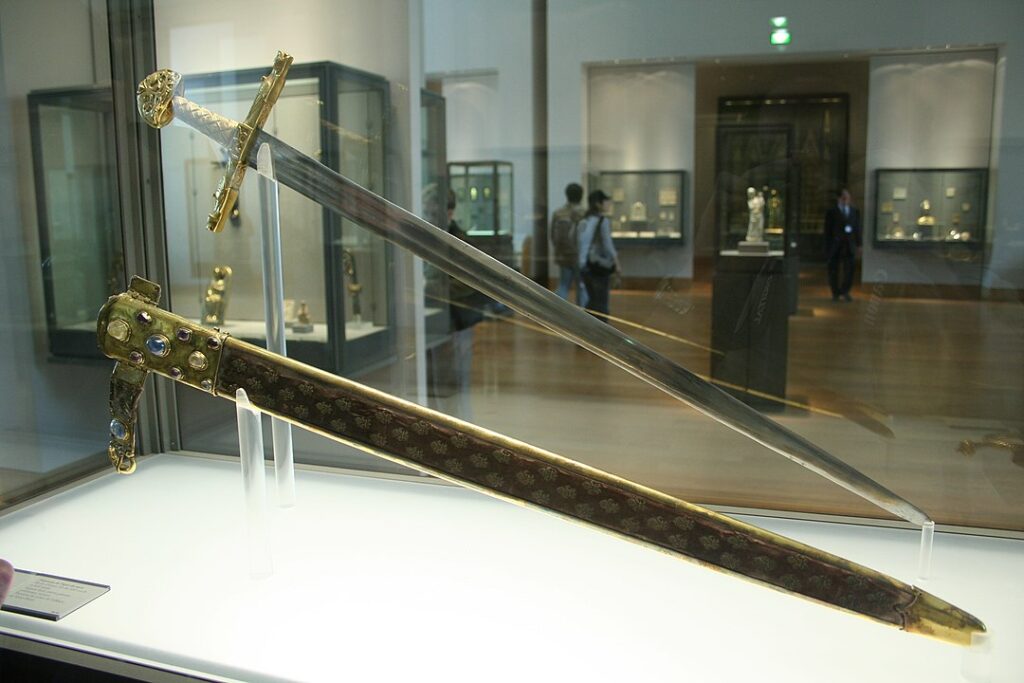
Joyeuse is the legendary sword of Charlemagne, the famous king of the Franks and the Holy Roman Emperor in the Middle Ages. The name of the sword means “joyful” in French. The sword has various extraordinary properties attributed to it in different versions of the legend and the stories that followed. Some of the most common features of Joyeuse are:
- Forged by the legendary blacksmith Wayland the Smith, known for crafting the swords of heroes like Sigurd and Beowulf, this weapon holds a remarkable history.
- Fashioned from the same metal that formed Longinus’s lance, the spear that pierced Jesus Christ’s side on the cross, it possessed an otherworldly brilliance. This radiance could illuminate the night, akin to daylight, and left Charlemagne‘s adversaries blinded by its splendor.
- Accompanied by a twin sword named Durandal, which was entrusted to Charlemagne’s paladin Roland, this formidable blade played a pivotal role in defending the rear guard during the Battle of Roncevaux Pass.
- Reputedly indestructible and unrivaled in battle, it could effortlessly cut through any armor or shield.
Joyeuse is one of the most famous and iconic symbols of the Carolingian legend and has inspired many works of art, literature, and media throughout history.
Caladbolg
A sword from Irish mythology, wielded by heroes like Fergus mac Róich and Cu Chulainn. It was known for its incredible cutting power.
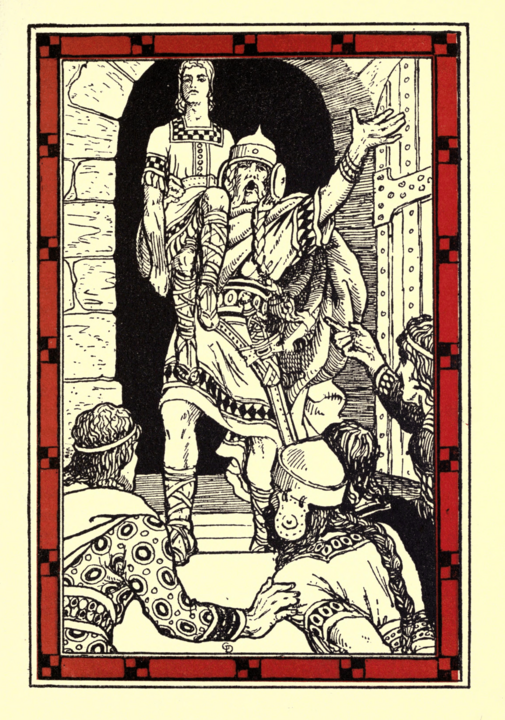
Caladbolg (Welsh: Caledfwlch) is a legendary sword in medieval Welsh literature associated with Fergus from the Ulster Cycle of Irish mythology. Caladbolg (Old Irish: Caladbolg) is linked to Caledvwlch and is also identified with Excalibur from later Arthurian literature in the Matter of Britain. Caladbolg is also associated with the lesser-known hero Fergus mac Léti from the Ulster Cycle, indicating a merging of two legends. In some legends, it is said to be a two-handed sword that, when swung, would curve like a rainbow and could cut the tops of hills and destroy entire armies.
Caladbolg can be linguistically related to Cú Chulainn’s spear, Gáe Bulg, or to King Arthur’s own Caliburn, which is called Caledvwlch in ancient Welsh mythology. The original versions of the myth used Cú Chulainn.
During the events of the Táin Bó Cúailnge, Ailill mac Mata takes Caladbolg from Fergus when he learns of Fergus’s relationship with his wife, Medb. He returns the sword to Fergus when he fights against the Ulaid people. Fergus sows chaos against the forces of Ulaid with his sword, but Conall Cernach convinces him not to kill Conchobar mac Nessa. Instead, Fergus delivers the ‘Three Great Strikes’ on three small hills, shattering their peaks.
The name Caladbolg, in Old Welsh, literally means “hard cleft.” It appears in the plural form as a generic term for “great swords” in Irish translations of classical literature from the 10th century. Sometimes, it is written as Caladholg, meaning “hard blade.”
Curtana
The ceremonial sword of the British monarchy, it symbolizes the monarch’s role as the defender of the faith.
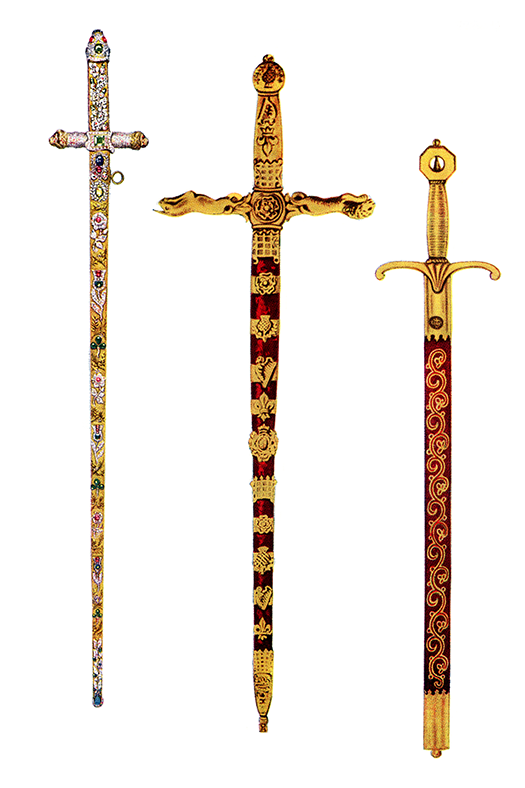
Curtana, also known as the Sword of Mercy, is a ceremonial sword that is used at the coronation of British monarchs. The sword has a blunt tip, which symbolizes the sovereign’s mercy and clemency. The sword is said to have belonged to x, the last Anglo-Saxon king of England, who died in 1066. The sword was then passed down to his successors, and it has been used in every coronation since then.
The sword is made of steel, iron, copper, and wood and has a “running wolf” mark on the blade, which indicates that it was forged by a Germanic smith. The sword also contains relics of saints in its hilt, such as a fragment of the True Cross and a tooth of St. Edward. The sword has a red velvet scabbard, which was made for the coronation of George IV in 1821. The scabbard is decorated with gold embroidery and silver-gilt emblems of roses, thistles, and fleurs-de-lis.
Curtana is one of the three swords that are carried in the coronation procession, along with the Sword of Temporal Justice and the Sword of Spiritual Justice. These swords represent the kingly virtues of justice and mercy, and date back to the coronation of Richard the Lionheart in 1189. The Sword of State, which symbolizes the royal authority, and the Sword of Offering, which signifies the monarch’s duty and knightly qualities, are also used in the coronation ceremony.
Masamune
Goro Nyudo Masamune, often referred to simply as Masamune, was a famous Japanese swordsmith from the Kamakura period (13th century). His swords are celebrated for their exceptional craftsmanship and artistic design.
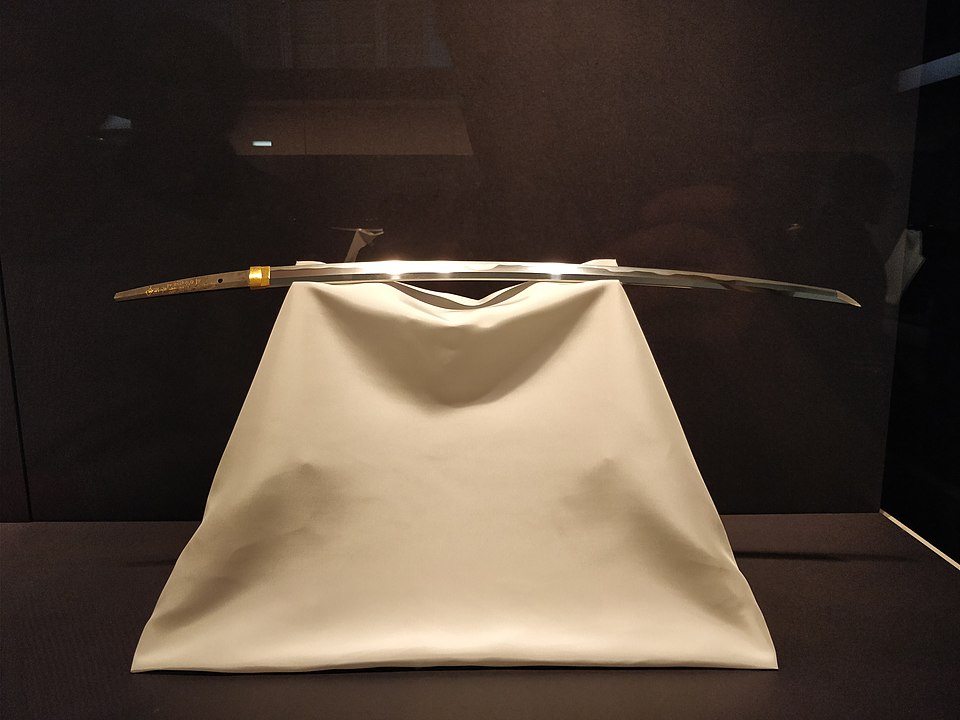
The Masamune sword takes its name from the legendary Japanese swordsmith Goro Nyudo Masamune, who is believed to have lived during the late 13th and early 14th centuries. Masamune is often regarded as one of the greatest swordsmiths in Japanese history, and his swords have been the subject of admiration and fascination for generations. His craftsmanship marked the pinnacle of Japanese swordmaking and contributed to the country’s rich swordsmithing tradition.
What sets the Masamune sword apart are its unique characteristics:
- Masamune’s swords are renowned for their sharpness and cutting ability. They are said to have been so sharp that they could cut through multiple bodies with a single stroke.
- Masamune’s swords are celebrated not only for their functionality but also for their aesthetic appeal. The blades are often beautifully designed and ornamented, featuring intricate details on the hilt and scabbard.
- The process of creating a Masamune sword is a testament to the dedication and skill of Japanese swordsmiths. It involves the meticulous folding and forging of steel, resulting in blades with a distinctive grain pattern called “hada.”
The Masamune sword, like many legendary blades, carries with it an air of myth and mystery. One of the most famous stories associated with it involves a competition between Masamune and another renowned swordsmith, Muramasa. According to the legend, the blades of these two masters were tested by suspending them in a river. Muramasa’s sword cut everything that touched it, including leaves and fish, while Masamune’s sword only cut the leaves but allowed the fish to pass unharmed. This story reflects the contrasting philosophies of the two swordsmiths, with Muramasa’s blades being known for their aggression and Masamune’s for their precision and control.
Kogarasu Maru
This legendary sword, whose name translates to “Little Crow,” is known for its unique shape. It was created by Amakuni, an ancient swordsmith, and is considered one of Japan’s national treasures.
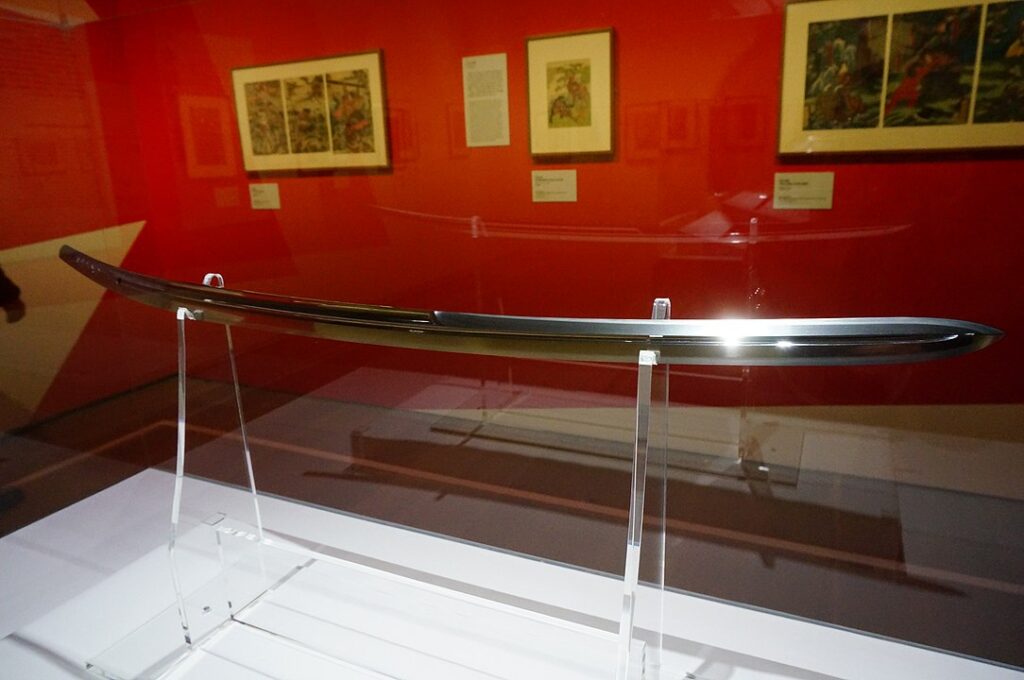
The Kogarasu Maru sword, also known as the “Little Crow” or “Karasu” sword, is a renowned Japanese tanto, a type of short sword, with a distinct design. Its origin traces back to the Heian period (794–1185 AD), making it over a thousand years old. The sword is part of Japan’s cultural heritage, and its history is shrouded in legends and folklore.
Key features of this masterpiece include:
- The distinctive hamon, the visible temper line on the blade, is characterized by its wavy pattern, adding both beauty and functionality to the sword.
- The sword’s fittings, including the tsuba (guard) and kashira (pommel), are crafted with meticulous attention to detail, often featuring intricate engravings or inlays.
The Kogarasu Maru sword holds cultural significance in Japan and is considered a national treasure. Its historical importance is twofold:
- During the Heian period, the sword was a symbol of a samurai’s status and honor, and it is said to have been wielded by legendary samurai.
- The Kogarasu Maru sword has inspired artists, poets, and writers throughout history. Its beauty and elegance have found their way into countless works of literature and art.
The Kogarasu Maru sword is currently housed in the Tokugawa Art Museum in Nagoya, Japan.
Muramasa
Swords made by the Muramasa school, especially Sengo Muramasa, are infamous for their alleged bloodthirsty nature. It is said that those who wielded a Muramasa blade were destined for violence.
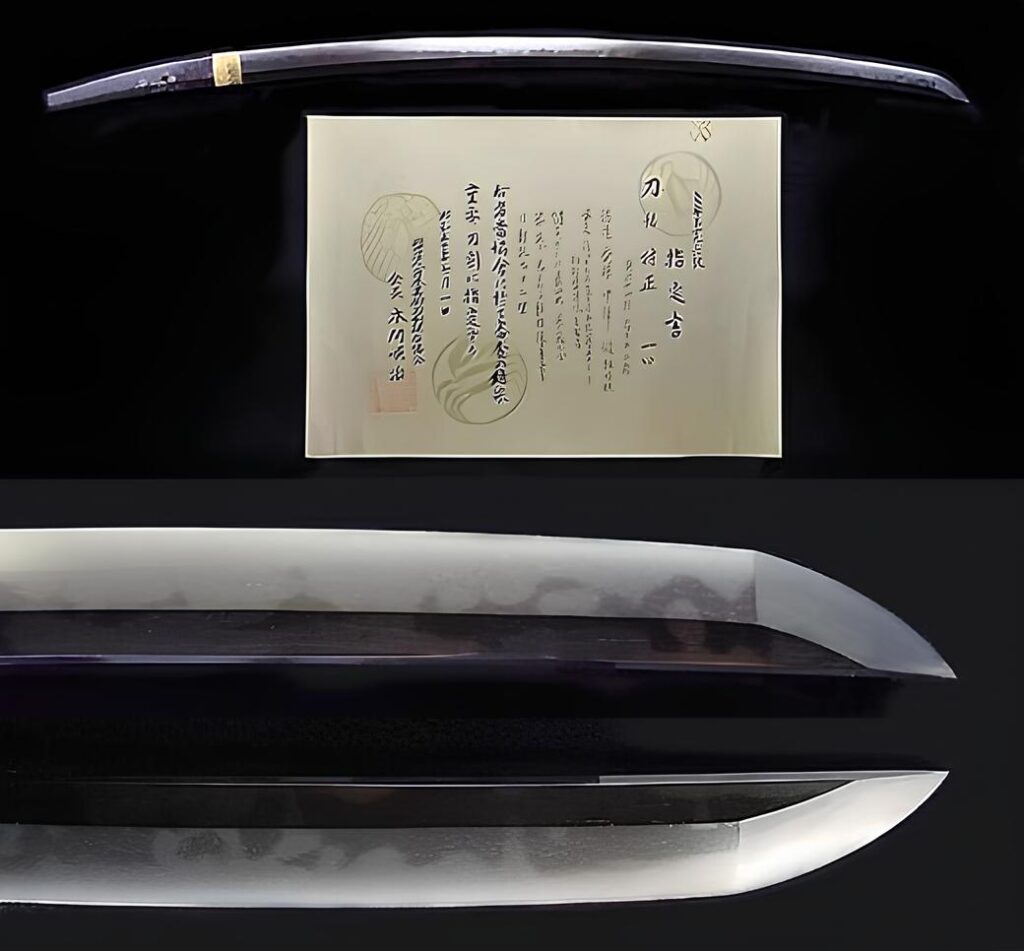
The origins of the Muramasa sword are shrouded in mystery, much like many legendary blades. It is believed to have been created by the master swordsmith Muramasa Sengo, who lived during Japan’s Muromachi period (approximately 14th to 16th centuries). Muramasa’s swords were renowned for their sharpness, and he employed a unique two-layer steel forging technique known as “soshu-kitae.” This method involved layering hard and soft steel to create a blade with a razor-sharp edge.
The Muramasa sword is infamous for its reputation as a “bloodthirsty” blade. Legends and stories surrounding this weapon suggest that it had a malevolent spirit, causing its wielder to become consumed by a murderous rage. Some stories even claim that the sword would drive its owner to commit acts of violence, making it a cursed weapon.
One of the most well-known stories involves Tokugawa Ieyasu, the creator of the Tokugawa Shogunate, conducting a test. He is said to have tested two swords—one made by Muramasa and another by Masamune, a rival swordsmith. The Muramasa sword supposedly cut through everything with ease, but it was difficult to sheathe because it was so “bloodthirsty.” In contrast, the Masamune sword was sharp but had a more peaceful and calm nature, allowing it to be sheathed without issue. As a result, Tokugawa Ieyasu favored the Masamune sword.
Gram
A sword of Norse mythology, Gram was wielded by the hero Sigurd and used to slay the dragon Fafnir.

Gram, also spelled Gramr, is the name of the sword that the hero Sigurd used to slay the dragon Fafnir in Norse mythology. The sword was originally owned by Sigurd’s father, Sigmund, who received it from the god Odin. However, the sword broke when Sigmund fought against Odin disguised as a stranger. Sigurd later reforged the sword from the fragments and used it to accomplish many heroic deeds.
Gram is described as a very powerful and sharp sword, capable of cutting through an anvil and a dragon’s scales. It is also one of the few weapons that can injure Odin himself. The name Gram means “wrath” or “fury” in Old Norse, reflecting its destructive nature. Gram is one of the most famous swords in Norse mythology and has influenced many other works of fiction and fantasy.
Zulfiqar
The double-pointed sword associated with Imam Ali, the cousin and son-in-law of the Prophet Muhammad, in Islamic tradition.
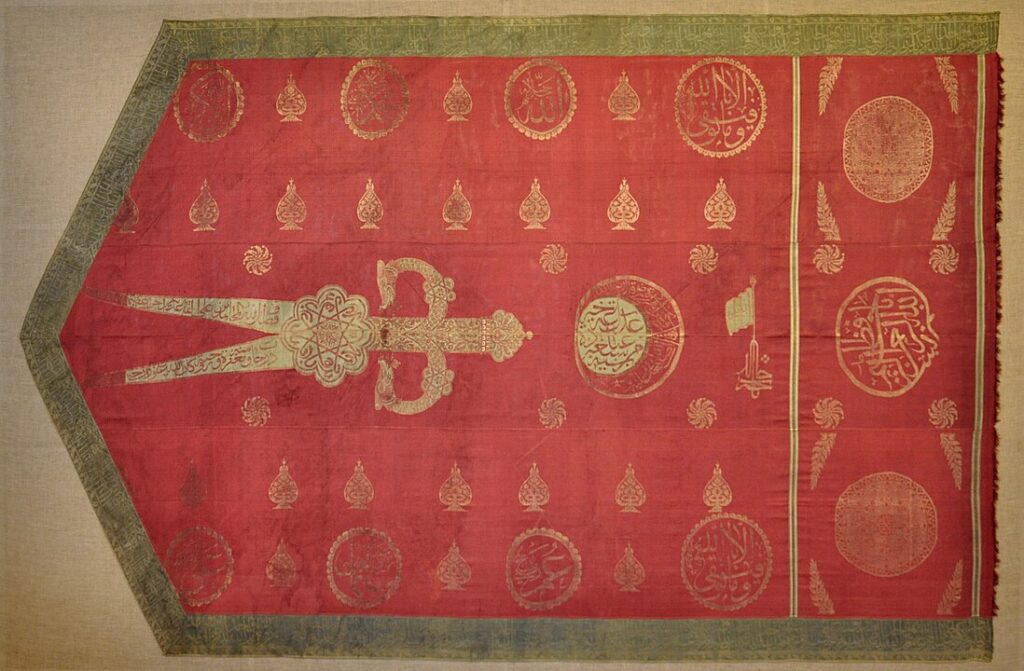
Zulfiqar, also spelled Dhulfaghar, Zolfaaghar, Dhu al-Fiqar, Dhu l-Faqar, Thulfeqar, Dhulfiqar, Zoulfika, or Zülfikar, is the legendary sword of Imam Ali, the son-in-law and cousin of Prophet Muhammad in Islamic tradition. The sword is said to have been given to Ali by Muhammad or by the archangel Gabriel and to have been used by Ali in several battles. The sword is famous for its bifurcated or double-pointed blade, which is often depicted as a scimitar in modern Shia iconography. The name Zulfiqar means “the spine splitter” or “the severer of the vertebrae” in Arabic, reflecting its destructive power.
Zulfiqar is one of the most revered and mysterious swords in history and has inspired many legends and stories. It is also one of the symbols of Shia Islam and is often used as a talisman or an emblem of piety, justice, and strength. A well-known saying attributed to the archangel Gabriel proclaims: “There is no hero like Ali; there is no sword like Zulfiqar.” This phrase is sometimes engraved on sword blades or other objects. According to some traditions, Zulfiqar still exists today and is kept by the Mahdi, the hidden Imam who will return at the end of time.
Hrunting
In the epic poem “Beowulf,” this sword was given to Beowulf to fight the monster Grendel’s mother. It ultimately failed him in that battle.
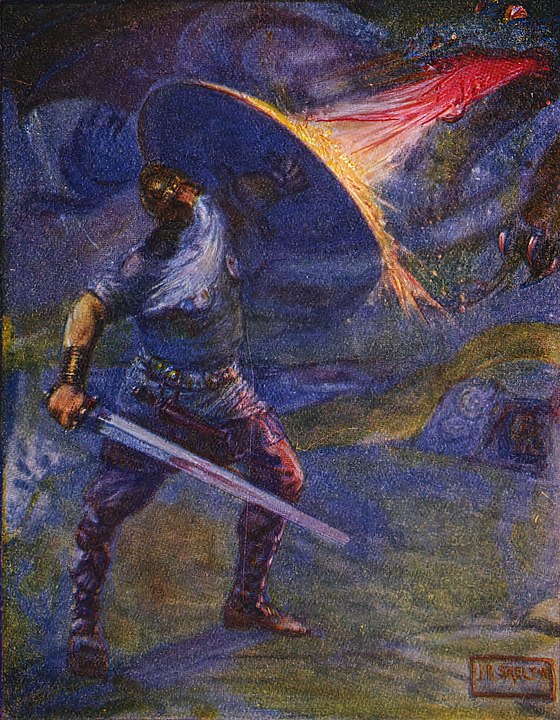
It is a sword that appears in the Old English epic poem Beowulf, which dates back to the 8th or 9th century. It belongs to Unferth, the counselor of King Hrothgar, who lends it to Beowulf when he goes to battle Grendel’s mother, a monster terrorizing the kingdom. The sword is described as a powerful and magical weapon, one that has never failed its wielder, but it proves unable to harm the creature.
Beowulf must then use another sword found in the treasure of Grendel and his mother to defeat his foe. Hrunting symbolizes courage, generosity, and loyalty, but also failure and disappointment
Durandal
A famous sword from the medieval epic “The Song of Roland,” it was wielded by Roland, a Frankish knight, and is said to be indestructible.
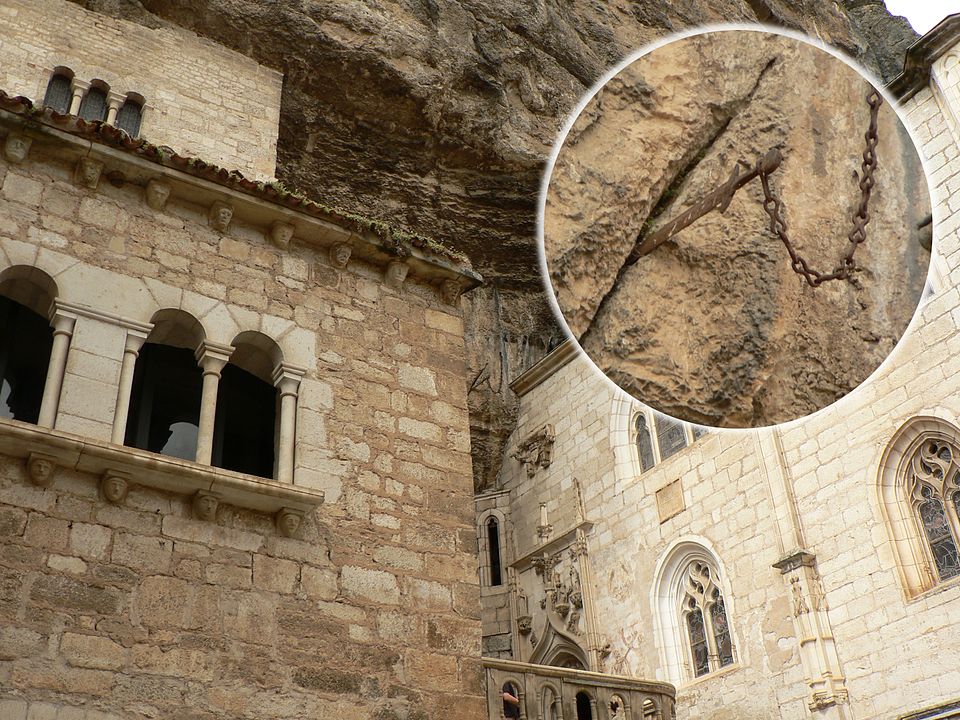
Durandal is a legendary sword from medieval European literature, particularly associated with the epic poem “The Song of Roland.” It is said to be the weapon of Charlemagne’s paladin Roland, one of the Twelve Peers of France. The sword Durandal is renowned for its strength and magical properties. In the legends, it is often depicted as an indestructible blade with various supernatural qualities.
Durandal played a significant role in the Battle of Roncevaux Pass, where Roland valiantly defended Charlemagne’s army, and the sword ultimately found its place in medieval chivalric tales and Arthurian legends.
Dojigiri
Forged by the renowned swordsmith Yasutsuna, this sword is historically significant and is believed to have been used by Minamoto no Yoritomo, the founder of the Kamakura Shogunate.
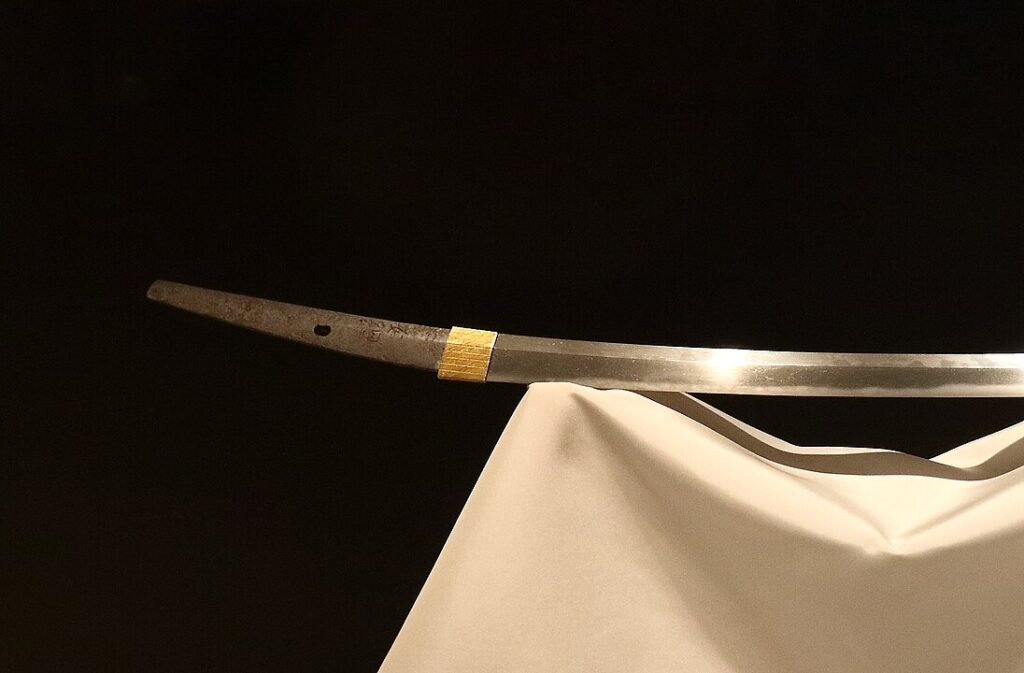
Dōjigiri, also known as Dōjikiri Yasutsuna or Dōjigiri Kyōhō, is a Japanese sword made by Yasutsuna, a famous swordsman who lived during the Heian period (794–1185). This sword is one of the five greateast swords declared Japan’s National Treasure. Each of these swords is attributed to Yamato Takeru, a legendary hero in Japanese mythology who is said to have slain a dragon.
Dōjigiri’s name comes from a story that illustrates the sword’s sharpness. According to this story, Yamato Takeru, while fighting a dragon, plunged his sword into the dragon’s neck. Before the dragon died, it turned its head to look at Yamato Takeru, but the sword was so sharp that it completely severed the dragon’s neck. Hence, the sword was named Dōjigiri, meaning “Dragon (Dōji) Cutter”.
The Dōjigiri sword has belonged to many important people in Japanese history. One of them is Date Masamune, a famous warlord during the Sengoku Period (1467–1600). Date Masamune inherited the Dōjigiri from his father, Date Terumune. Date Masamune used the sword in many battles and considered it one of his favorite swords. Date Masamune left Dōjigiri to his son Date Tadamune before his death. As Date Tadamune served as a loyal vassal to the Tokugawa shogunate, the sword passed to the Tokugawa family.
Today, the Dōjigiri sword is on display at the Tokyo National Museum.
Onimaru Kunitsuna
A sword associated with the legendary warrior Minamoto no Yorimitsu, it was said to have been used to slay oni (demons) in Japanese folklore.
